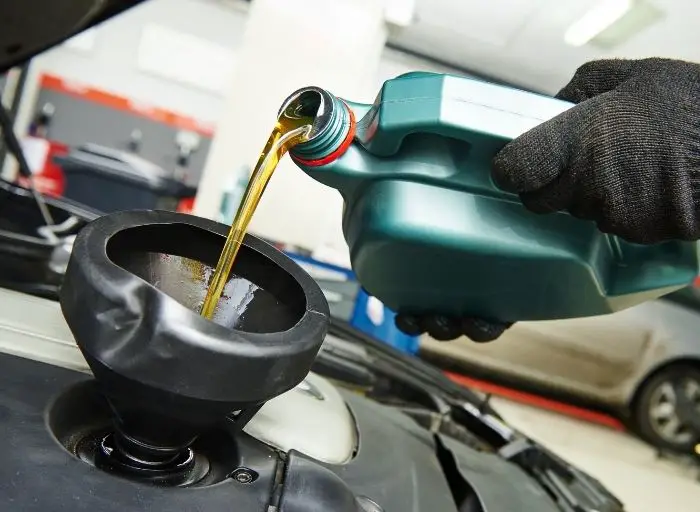
In this blog, you will learn about mixing different types of motor oil, especially can you mix 5w30 and 10w30, why it matters, and what you should do if you are in the market for new motor oil.
The short answer is:
Yes, you can mix the two oils. 5w30 & 10w30 have the same degree of viscosity at the same temperature, which makes them blend nicely together in your car. So mixing them is safe and won’t seriously harm your engine.
Table of Contents
Can You Mix Engine Oils?

It’s not advisable to mix two different types of oils in your vehicle, but many drivers do that, and it hasn’t affected their engine or transmission yet. Apparently, there are different kinds of oils, and each kind has a different viscosity, and each kind of oil contains different additives.
It is very important that you understand the differences between the two oils you’re going to mix together. But motor oil does just one thing. It keeps your engine lubricated. It doesn’t matter whether your car is a Cadillac or a Chevy. Make sure all those gears are engaged and functioning smoothly. If they’re not, it’s like your car is missing gear. A car with missing gear won’t run very far, or at all, and it will eventually overheat and need repair.
5W30 vs 10W30

The thickness is the key distinction between 5W30 and 10W30.
The 5W30 is thinner and more effective than the 10W30, so it can get to the hard-to-reach engine parts even when the temperature is low.
10W30, on the other hand, is thicker and ideal for heavy-duty engines.
Can You Mix 5w30 And 10w30?
Yes, you can. Running 10W30 in addition to 5W30 will not harm your engine. Adding 10W30 to your current mix is safe and will not cause your engine to run any worse. But it’s not necessarily ideal. But keep in mind that 10W30 has more density than 5W30. These two engine oils are very similar in viscosity; hence, they might mix perfectly in your engine. Therefore, you can mix 5W30 with 10W30 with no ill effects whatsoever.
Using only one type of oil for your engine is the best choice, especially if you have a high-performance engine. However, there is usually one recommended oil, in particular, that is better than all others.
However, we advise sticking with the specific engine oil that the automaker suggests. This is the best way to get the most out of the oil instead of switching to homemade blends or other kinds of oil.
Oils with similar weights but different viscosities can be equivalent at operating temperatures. But when it’s cold, they won’t stay the same. The oil that is less viscous or thinner will flow more easily to the upper ends.
Thus, regardless of their cost, combining 10W30 and 5W30 is safe and won’t cause any damage to your engine. But it’s best to continue using the oil that your car’s manufacturer suggests.
Does Mixing 5W30 with 10W30 Affect Your Car?

Generally, you can mix any two different oils (whether they differ by type or viscosity), but it tends to decrease your engine’s performance and shorten the interval between oil changes.
This is because the additives in the oil won’t blend with the other additives in the engine. Thus, your engine won’t get the most out of both oils. This is important if you drive your vehicle in cold weather. At low temperatures, with the differences in the viscosities of these oils, your engine components may not get full advantages of the oil.
In fact, thicker oils like 10W30 are actually meant for engines that carry heavier loads, so they are thicker when cold. That makes it better in colder temperatures. However, in warmer weather, thinner oils work better because they provide more lubrication.
This does not cause any harm to your car; rather, it simply means your engine is getting more of what it needs to run at its peak. The worst scenario is usually when you lose your warranty. In most cases, this will happen when you have an unexpected problem with your car.
How can I Mix 5w30 With 10w30?

Can I combine 10w30 and 5w30? Yes, you can, if you know how to do it. The key strategy is to pour the light oil into the engine first while combining the two types of oil in various weights.
So, in this case, pour 5w30 first.
The heavier oil, 10w30, should then be added after 5w30. The motor oils can be appropriately blended in this manner.
The combination of synthetic and conventional oils is one thing you should never do.
It is crucial to weigh the engine oils you plan to add; they should be close in weight so that they can operate at the same speed.
When determining its proper weight, the weather is also a crucial consideration to avoid damaging the engine.
Final Thought
So, can you mix 10w 30 and 5w 30? Yes, you can mix oils with different weights or types. However, I wouldn’t recommend it. Because mixing two or more oils at the same time dilutes their effectiveness and makes it more likely for a negative experience to occur. This is also true for most other vehicles, not just cars, as mixing oils can void your warranty.
Further Reading:
Hi there! I’m Naomi O’Colman. I’ve got years of experience working at an auto repair shop here in Texas under my belt. On top of that, ever since I was a kid I’ve been passionate about the auto industry. Since I’ve joined the team at automotivegearz.com I’ve been enthusiastically sharing my passion and insights with my readers. I’m dedicated to delivering high quality content and helping you stay up to date with the latest automotive trends and products out there!







